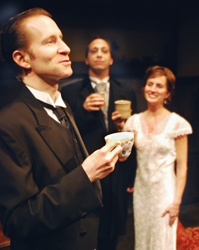From the Chicago Sun-Times
Playwright, cast maintain just the right tone
May 13, 2009
By Hedy Weiss
HIGHLY RECOMMENDED
The press is all abuzz in anticipation of the impending marriage of Lord Peter Wimsey, the upper-crust amateur detective and man of bachelor ways, to his formerly notorious bride, detective writer Harriet Vane. But this is one savvy couple, and the pair has every intention of eluding the media. Rather than heading for some posh hotel in Paris for a honeymoon, the Wimseys plan to enjoy a quiet getaway in their newly purchased old house in rural Hertfordshire.
Of course their best-laid plans go awry almost immediately in “Busman’s Honeymoon,” Lifeline Theatre’s spirited comedy of newlywed manners and murder most vile. And their travails become the audience’s delight as the previous owner of the house is found dead, the house is without a working heating system, the village eccentrics file through as suspects and bill collectors and the Wimseys’ honeymoon passion (palpable in that oh-so-English way) is continually disrupted.
This is Lifeline’s fourth production based on works of Dorothy L. Sayers, whose between-the-world-wars detective stories captured a period of rigid class lines and burgeoning feminism in Britain. Frances Limoncelli, the deft and witty adapter, has maintained the smart, drolly comic tone that defines these stories. So have actors Peter Greenberg (an ideal embodiment of Lord Peter, an aristocrat far deeper than he lets on) and Jenifer Tyler (a steely twig of a woman clearly altered by love).
There is a third person in the room much of the time, and he all but steals the show. He is Bunter, the loyal, ingenious and proper valet to Lord Peter, and he gets a show-stopping portrayal here by Phil Timberlake. Some of the more touching and deliciously played moments in “Busman’s Honeymoon” are those in which Harriet tries to figure out how to relate to Bunter without damaging the relationship between Lord Peter and his valet. But the best moment occurs when Bunter simply loses it (for a reason I will not give away).
Under Paul S. Holmquist’s fleet direction, there is zesty character work by Adam Breske, David Skvarla, Robert Kauzlaric, Kate Harris, Millicent Hurley, Christopher M. Walsh, James E. Grote and Paul Myers. Mary Griswold’s rustic set and Brett Masteller’s sound set the mood. Pour the port.
From the Chicago Tribune
Return of the proper English detective in Lifeline’s ‘Busman’s Honeymoon’
May 15, 2009
By Chris Jones
Precisely how a little theater in the throbbing, multicultural heart of Rogers Park became such a dab hand at the genteel and archaic form of English detective fiction, circa 1935, is, well, something of a mystery. But as Dorothy L. Sayers’ aristocratic detective Lord Peter Wimsey might say, there you have it, chaps and chapesses.
Jolly good for them. And jolly good for you, if you like classy whodunits of the droll and well-spoken kind.
Lifeline’s latest foray into the world of rambling old homes, rambling local eccentrics, dry-witted manservants, perfectly prepared port, well-brewed tea and dead bodies is “Busman’s Honeymoon.” This yarn is a sequel to “Gaudy Night,” wherein, even as he solved a tricky murder mystery, amateur sleuth Lord Peter became enamored of the charms of a moderately racy author of detective fiction by the name of Harriet Vane.
As the title of “Busman’s Honeymoon” (1937) aptly suggests, Lord Peter and Harriet have by now made their love official, in their rather geeky way. But wouldn’t you know it? Their honeymoon locale comes replete with a corpse in the wine cellar.
Actually, it takes a while for the body to show up, delaying excitement that came faster in the slightly superior “Gaudy Night.” But once the mystery is under way, this show ripples along in a most pleasing fashion.
Lifeline isn’t just trotting out a peer of “The Mousetrap.” All four of its Sayers productions (including “Strong Poison” in 2004 and “Whose Body?” in 2002) have been original adaptations by Frances Limoncelli, an unsung talent of the Chicago theater. They’re all excellent dramatizations — witty, smart and exquisitely toned, with enough self-awareness to freshen the genre without undermining its conventions.
Happily, Lifeline long ago found Peter Greenberg to play Lord Peter — a character whom Sayers reportedly described as landing somewhere between Bertie Wooster and Fred Astaire. Greenberg is closer to the former that the latter, but his English accent is close to perfect, and he pays attention to his fellow’s little insecurities, thus rounding out the character. The charming Jenifer Tyler, who first played Harriet in “Gaudy Night,” is back once again. She also has exactly the right balance of tone.
To their credit, director Paul S. Holmquist and his actors clearly understand that there’s certain complacency to aristocratic detectives. You see that here — the story isn’t spoofed but presented honestly with a surprisingly full subtext, revealing some of Sayers’ more troubling assumptions about class and gender.
Aside from the business of who killed the corpse (about which I will write nothing), most of the fun comes from the existence of an intimate triangle composed of Lord Peter, his moderne bride and his faithful manservant, Bunter (played with both simplicity and complexity by Phil Timberlake). It’s a strange setup, as all three of them know, but as Lord Peter observes, a man with faithful wife and faithful servant could never be said to lack for friends. If the many ways to parse that statement get you going, this is your show.
From the Chicago Reader
May 21, 2009
By Laura Molzahn
Adapter Frances Limoncelli says good-bye to a much-loved writer in this fourth and final of Lifeline’s plays based on Dorothy L. Sayers’s murder mysteries. Limoncelli’s finely honed her appreciation of the novelist’s wit and erudition over the course of the series; Paul S. Holmquist’s lovingly detailed staging does her script justice, lavishing attention on every look and gesture from Peter Greenberg as the lofty Lord Peter Wimsey, Jenifer Tyler as his brand-new bride, and Phil Timberlake as the fastidious valet. Their supercilious wit cloaks a deep care for others and highlights the cluelessness of the local bumpkins: a sweep protective of his chimneys, a cranky housekeeper, and a dithery church organist, also the niece of the deceased. The impeccable details include well-differentiated accents courtesy of dialect coach Elise Kauzlaric.
From Chicago Free Press
May 21, 2009
By Web Behrens
Cranking out yet another excellent production is what Lifeline does best, although you’re never sure where the company might take you. From the vivisection horrors of “The Island of Dr. Moreau” to the swashbuckling pulp of “The Mark of Zorro” to a convent’s tense spiritual divide in “Mariette in Ecstasy,” this seasoned Rogers Park ensemble seems to know no boundaries. Now they return to the soufflé-light blending of British wit and drawing-room mystery of Dorothy L. Sayers. Again adapted by Frances Limoncelli, it’s no surprise that “Busman’s Honeymoon” follows in its three predecessors’ successful footsteps.
Interestingly, this time around the plot focuses not on the mystery (a crime isn’t even discovered until well into the first act) but on the newlywed relationship of Lord Wimsey and Harriet Vane. Much the show’s joy comes from depicting this middle-aged bachelor’s confident yet delicately measured steps into all aspects of matrimonial companionship. (This is, after all, the veddy veddy proper world of 1930s England.) Heading up a typically strong ensemble, Peter Greenberg and Jenifer Tyler portray the central couple with suitably subtle passion and plenty of intellectual fire.
Director Paul S. Holmquist corrals a large cast, deftly staging a number of busy scenes across Mary Griswold’s smart two-tiered set. As they build towards the second-act reveal, we get fine supporting turns from Robert Kauzlaric, Millicent Hurley, Kate Harris and, most of all, Phil Timberlake (as the near-unflappable Bunter). The solution’s charm comes from the reveal that the crime had partly been executed before our very noses – but the play’s lasting punch comes from its unexpected but emotionally powerful coda, reminding us that murder is not really about entertainment.
From Windy City Times
May 20, 2009
By Mary Shen Barnidge
An aristocrat-turned-sleuth rescuing a mystery writer from a charge of murder is hardly “meeting cute,” but in 1930 Dorothy L. Sayers introduced Lord Peter Wimsey to Harriet Vane and, thus, was born one of the most romantic duos in detective fiction (or detectives in romantic fiction, if you prefer) . Lifeline Theatre reunited the couple in 2004 with its page-to-stage adaptation of Strong Poison, contracting the sweethearts’ engagement in 2006 with Gaudy Night and their subsequent marriage with this final installment in the trilogy.
We open with the high-profile newlyweds having evaded the paparazzi by eloping to a picturesque cottage in the English countryside. No sooner do they arrive, however, than the house’s previous tenant is found bludgeoned to death in the basement, leaving the flustered bride and groom to negotiate their post-nuptial accords while simultaneously tracking down a killer. But not for nothing did Sayers originally subtitle her narrative, “A Love Story with Detective Interruptions.” By the time we are finished, the culprit has been exposed and the marital commitment reaffirmed.
And all in a swiftly-paced two and a half hours, too. Frances Limoncelli’s tidy script proceeds smartly under Paul M. Holmquist’s brisk, but never overhurried, direction. Peter Greenberg and Jenifer Tyler reprise their roles as the worldly lovers, flanked by Phil Timberlake as their unflappable (well, almost unflappable) butler. Millicent Hurley and James E. Grote as sturdy bucolic tradespersons. David Skvarla and Adam Breske as the local constabulary. And Rob Kauzlaric, Kate Harris, Paul Myers and Christopher M. Walsh as assorted suspects. (Playgoers whose previous acquaintance with Lifeline’s stock company of actors leads them to anticipate the identity of the criminal are requested not to share their theories with fellow audience members.)
In the end, however, our reward is not just who dunit – although Sayers provides plenty of speculative motives and means before the puzzle is resolved – nor is it merely clever stagecraft (like the car headlights that signal the honeymooners’ covert arrival at their rural refuge), but the author’s ruminations on the forging of an ideal partnership between men and women desirous of such egalitarian relationships. As Lord Peter himself declares to Harriet and Bunter, “A man is rich in friends who has a good wife and a good servant, and I hope I may [never] give either of you cause to leave me” – a vow reflective of a literary genre invoking a universe substantially more orderly than our own.
From Chicago Stage Review
May 17, 2009
By Venus Zarris
Proving once again that they are the city’s adaptors extraordinaire, Lifeline Theatre closes its 26th season with the elegantly entertaining Busman’s Honeymoon. This is the fourth in a series of award-winning adaptations, by Frances Limoncelli, of Dorothy L. Sayers’ romantic Wimsey mysteries. Limoncelli is a genius at capturing the charm and playful intrigue of the original books and Lifeline is brilliant at bringing these adaptations to life.
This time the stylish story is set in a rustic country home, the honeymoon house for Lord Peter Wimsey and his lovely new bide Harriet. Although newlyweds, they have been in love for sometime and the tenderness that they share for each other is matched by their cleverness for solving a crime. The house is not quite up to spec for their nuptials though. It is easy enough to tidy up and change the sheets but the corpse in the basement requires a bit more attention!
Director Paul S. Holmquist tells a sharp story at a brisk pace with a sophisticated cast, striking the perfect balance between whodunit and love story with a generous helping of humor to ice this tasty cake. If period-piece murder mysteries are your fancy, you’ll be in heaven with Busman’s Honeymoon. Lifeline delivers a captivating construct of upper class detective dabbling.
The design elements are excellent but it is the picture perfect ensemble that really delivers the goods. Every character is created with exacting skill, resulting in a production that feels as good as it looks and sounds. Peter Greenberg (Lord Peter Wimsey) and Jenifer Tyler (Lady Harriet Wimsey) create a couples-chemistry that is heartwarming, cerebral, very British and splendid. Kate Harris is perfectly eccentric as Miss Twitterton But Phil Timberlake truly anchors the cast as Bunter, the butler. He creates an evocative character with remarkably subtle depth.
The reconstruction of the crime is good fun. There is excellent dramatic build to the criminal climax. And Busman’s Honeymoon succeeds at a stellar execution of two very different degrees and levels of drama, the murder mystery and the tender love story that prevails over complicated melancholy.
Lifeline proves that creating an episodic theatrical adventure, over the course of several plays, equals more character development. This pays off for the audience in ways that are both dramatically delicate and extraordinary. Busman’s Honeymoon is simply outstanding theater that should not be missed.
From Newcity
May 11, 2009
By Lisa Buscani
For a tiny island in the middle of a rough sea, England is so very dry, a dryness aptly demonstrated in Lifeline Theatre’s witty, intelligent “Busman’s Honeymoon.” The fourth in the “Lord Peter Wimsey, amateur sleuth” novels, this installment finds Lord Peter (Peter Greenberg), new wife Harriet (Jenifer Tyler) and ever-capable manservant Bunter (Phil Timberlake) honeymooning in their country house. Murder and mayhem ensue with all the stereotypical trappings: suspicious family members, disgruntled employees and a police constable who says “What’s all this, then?” Some things are clichés for good reason.
Reprising their roles, Greenberg and Tyler endow their characters with affection for each other and a good mystery. One difference: this story doesn’t stop with the catching of the killer. It follows Lord Peter through the trial and sentencing and shows the toll justice takes: the media frenzy, the execution. Who knew setting things right could feel so wrong?
RECOMMENDED
From Centerstage
May 10, 2009
By Anna Pulley
Common wisdom dictates that marriage is a three-ring circus: engagement ring, wedding ring and suffering. And in the case of “Busman’s Honeymoon,” the 4th Lifeline Theatre play adapted from the novels of Dorothy L. Sayers, nothing rings more true than that. Amateur sleuth Lord Peter Wimsey (Peter Greenberg) and his murder-mystery novelist bride, Harriet Vane (Jenifer Tyler), escape to the country for what they assume will be a peaceful honeymoon away from the paparazzi, only to discover that the man who sold them their new house has been found in the cellar, murdered.
Steeped in delicious restraint, martini-dry humor and enough double entendres to make Oscar Wilde blush in his grave, “Busman’s Honeymoon” is a delightful, though abruptly anguished, romp through murder-mystery mayhem. A tension-filled cast of townies are the suspects of the mystery and provide an unruly mixture of sympathy and camp, of heartache and stereotype. From a rifle-toting Vicar to a chimney sweep who leads the cast in an impromptu church-choir song, “Busman’s Honeymoon” has more local color than a gay pride parade. At the center of it all is the relationship between Harriet and Peter, made instantly fragile by circumstance, but the two’s tenderness and rapport give the play a sense of intimacy amid the relentless whirligig of scandal and intrigue.
Once the case has been solved, the play takes an unexpected turn for the hearse. Wimsey’s guilt for condemning a man to hanging causes both he and Harriet much turmoil, which is a rather jarring turn away from the play’s quippy and comedic beginnings. Perhaps Wimsey’s actions make more sense to seasoned viewers/readers of Sayers’s work, but as it was, the sudden stoicism stunts the appealing, bookish energy generated throughout the play. That aside, “Busman’s Honeymoon” is a charming jaunt down whodunit lane. To dismiss it would be a crime of another sort.





















